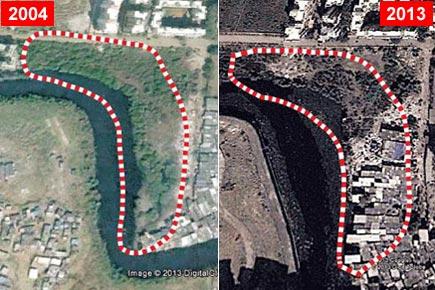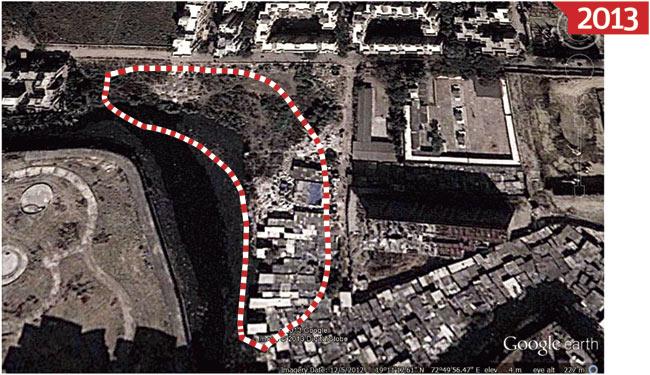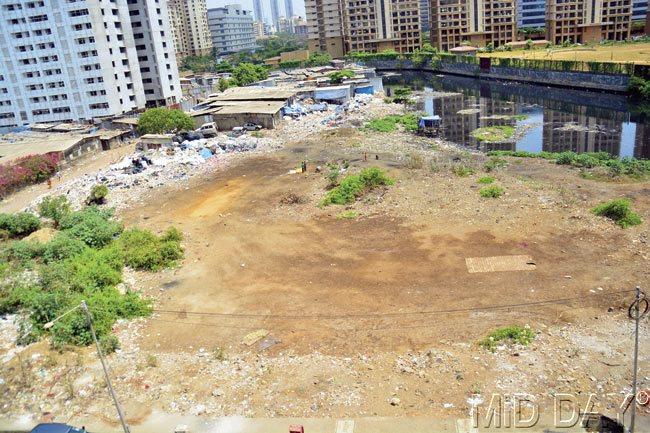These Google Earth images from 2004 and 2013 reveal how garbage and slums have now replaced the greenery in Evershine Nagar in Malad (W), as the BMC turned a blind eye

Illegal dumping of construction debris and the gradual growth of slums have led to the death of mangroves spread over an acre in Malad (West). The Brihanmumbai Municipal Corporation (BMC) virtually did nothing to save this valuable natural ally from being wiped out.
Also read: Under collector's nose, encroachment in BKC killing its mangroves
ADVERTISEMENT

The mangrove cover was on a patch of land in Evershine Nagar, in suburban Malad. Local resident Sharique Raza told mid-day, “I have been staying in this area for more than 10 years now. Earlier, the plot opposite the Neelkanth building was full of healthy mangroves. But from 2005, illegal dumping of construction debris started, which killed the plantation.”

This reporter visited the site and observed that the land had become completely barren in fact, it would be difficult to imagine the plot was covered with trees once. “Slums have also started coming up along the creek,” added Raza, who said he had complained about the decline of the mangroves to various government agencies.

In 2004, this patch of land was covered with healthy mangroves. It is now a barren plot with slums mushrooming along the creek. Pic/Prashant Waydande
Mangroves act as a natural barrier between the city and the sea waves. They also prevent soil erosion by trapping salt and debris, and thus, stabilise the coast (see box). If one looks up the satellite images provided by Google Earth from 2004, one can see a good cover of more than one acre on the patch of land. Compare it to the current image, and one can see how the land was denuded, and taken over by the Srilankapada slums.
Authorities apathetic
For the last two years, Raza has apprised the BMC’s P-North ward office, the collector’s office, tehsildar’s office, of the destruction of mangroves. But nobody has bothered to actually take preventive measures.
Also read: Last of the mangroves are Mumbai's new dumping grounds
“I want to save the mangroves and the plot from getting encroached by slums. From 2012, I have been complaining about this issue to various government agencies. I even complained to the tehsildar’s office, but they told me they couldn’t help me in this matter, as the land belongs to the BMC,” explained Raza.
The BMC, on its part, simply fined the dumpers and trucks for unloading their construction debris illegally. But no concrete steps were taken to stop the destruction. The 23-year-old feels that if this continues unabated, other mangroves, too, would meet the same fate, and that “the land mafia would kill them off.”
Also read: BMC fights for mangroves
Another local, on condition of anonymity, recollected that the area had a thick mangrove cover, but the land mafia had, over the years, eliminated it. “The slums of Srilankapada will eat the rest,” he warned. Mangroves activist Harish Pandey feels the laws have to be strengthened to save mangroves.
“It is really sad that the authorities are not at all serious about saving mangroves. The reason behind rampant killing of the trees is lax laws. Unless there is conviction in such cases, there won’t be fear in the minds of people who are wiping them out,” he said.
 Subscribe today by clicking the link and stay updated with the latest news!" Click here!
Subscribe today by clicking the link and stay updated with the latest news!" Click here!







